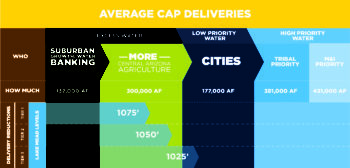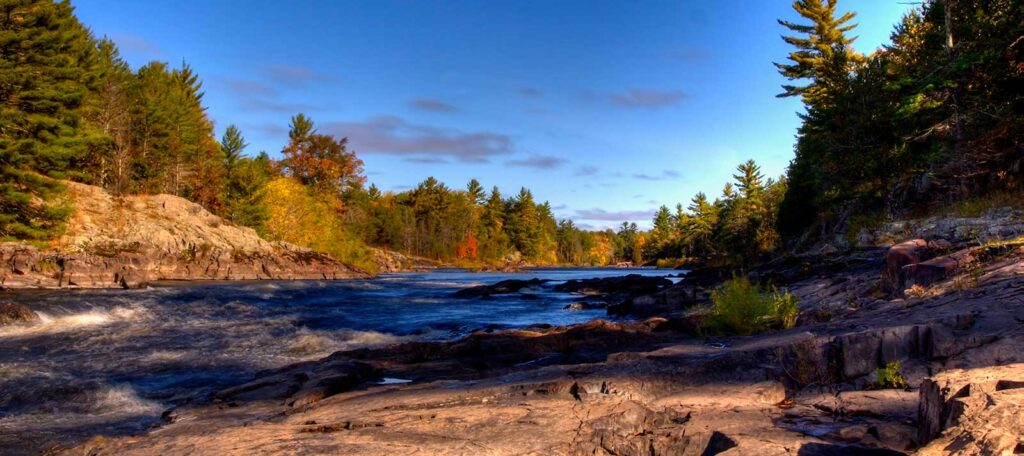Landmark Agreement Addresses Colorado River Basin Supply
The House of Representatives and the Senate approved the seven-basin state’s Drought Contingency Plan (DCP) and President Trump has now signed the bill into law.
It’s official. In early April, the House of Representatives and the Senate approved the seven-basin state’s Drought Contingency Plan (DCP) and on April 17th President Trump signed the bill into law. The speedy response from Washington allows the seven-basin states to act immediately to protect the Colorado River.
As we noted in an earlier post about the DCP, the plans are two separate, yet coordinated efforts for both the Upper and Lower Basins. By design, the plans work in tandem to better manage the shifting strains on the Colorado River system. The Lower Basin plan focuses on water reductions to stabilize water levels in Lake Mead, while the Upper Basin DCP establishes a regulatory pool of “conserved” water in Lake Powell (to be used as a bank for the Upper Basin), allows for reservoir reoperation and continues cloud seeding to improve snowpack.
The plans are a culmination of three years of hard work, collaborative compromise, and tense, yet vital, negotiations. The plans are complex, but were developed with a sense of urgency to prevent an immediate water crisis by creating incentives for water conservation and mechanisms for sharing and leasing water, while preserving existing rights, agricultural realities, and the long term support for the Colorado River.
Now that the plans have been approved by Congress and signed by the President, what’s next?
Now that the plans are authorized by the Federal Government, they go back to the states to be officially authorized. Then, the states can begin the implementation of the plan. Carrying out the plan looks different for every state, so while the plans are finalized, there is still much work to be done at the state level to implement the DCPs.
In Colorado, the Colorado Water Conservation Board (CWCB) is launching a feasibility study of a demand management program. is one of the ways Colorado (and the Upper Basin) is working to avoid “mandatory” cutbacks in water use. It works by creating a water market, where willing participants may choose to be paid changing how they use their water. For instance, a ranch may choose to change to a lower water-use crop or turn off their water to temporarily fallow a field. Conserved water will then be delivered through rivers and stored in the new, reserved “pool” within Lake Powell. The CWCB is studying this potential program to understand the opportunities and concerns from stakeholders around the state to hopefully develop a voluntary, compensated, and temporary demand management program that reduces water security risk and works for water rights holders and Colorado’s rivers as well.
To reduce the impact of mandatory cuts the state would take when Lake Mead levels hit 1,075 feet, Arizona agreed to additional, voluntary cutbacks at 1,090 feet. At the time of writing, the surface elevation of Lake Mead is 1,089.72ft. This means Arizona will reduce their Colorado River water allocation, primarily impacting agricultural users in Pinal County (most junior water users in Arizona). If and when levels in Lake Mead reach 1,075ft, then 1,050ft, then at the critical level of 1,025ft, additional reductions will occur in Arizona, Nevada and eventually California.

While the specific reduction levels are identified, exactly how they would actually be implemented is not yet finalized. As a part of Arizona’s work to implement the DCP, they will need to consider how to curtail water use as to reduce potential impacts so that municipalities, agriculture and the environment are preserved. The DCP also provides a mechanism for Mexico to participate as well, storing some of it’s water in Lake Mead to support those elevations as well.
In addition to implementing the DCP, the seven-basin states will soon be back at the negotiation table. In 2020, the renegotiations of what are known as the 2007 Interim Guidelines for Lower Basin Shortages and Coordinated Operations for Lake Powell and Lake Mead will begin. It’s important that as renegotiations start to shape up, stakeholders continue to collaborate in an effective manner. The river doesn’t follow political or geographic boundaries, but instead flows from its high, headwaters sources in Colorado and Wyoming into Mexico. We must also seriously consider climate change impacts, long-term planning and innovative, creative solutions to reduce water demand and keep rivers in the Colorado Basin healthy and flowing.
American Rivers is very involved at many levels in all of these negotiations. We are at the table in Arizona, and working diligently to help the Water for Arizona Coalition continue working with elected officials to both pass and implement the Arizona and Lower Basin DCP, while working to address the looming threats to Arizona’s groundwater withdrawals. We are also heavily involved in the development of the Upper Basin Demand Management program to support the Upper Basin DCP. Lastly, we are helping to lead the efforts to continue to advocate for full implementation of the Colorado Water Plan. Holistically, these efforts overall are guided by one key principle – doing what we can to promote the overall, system-wide health and vitality of the Colorado River. We are American Rivers, protecting rivers is what we do best.





1 response to “Landmark Agreement Addresses Colorado River Basin Supply”
We live in interesting times for sure.
I would like to hear more about what the upper basin states think they can realistically produce from voluntary curtailment of water for ag purposes. And, what do the other three upper basin states have planned for finding that liquid loose change to stash into Powell?
I contemplate this scenario… what if Utah irrigators were able to conserve, say, 80-90K ac-ft annually, and then ten years from now, the Lake Powell Pipeline goes into operation, taking its gulp of 86,000 ac-ft annually? What has been gained?
And how will the realistic volume of banked water compare with the annual flux of evaporation of the 110 mi long lake in an already hot and dry region experiencing aridification?
Thanks, I look forward to further information on this from AR.